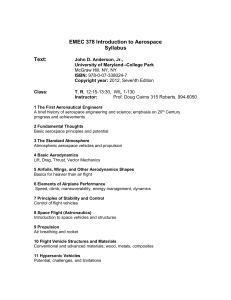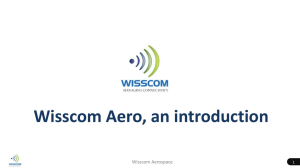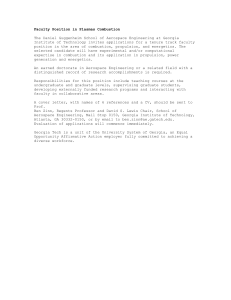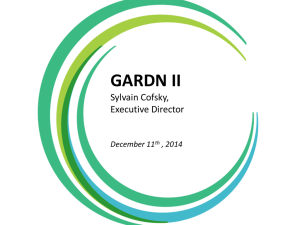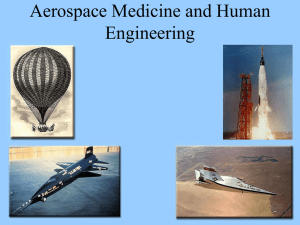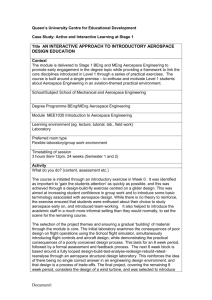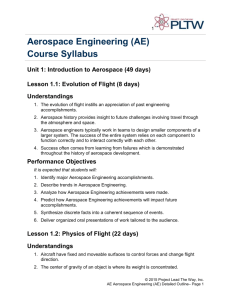Aerospace Engineering Detailed Outline
advertisement
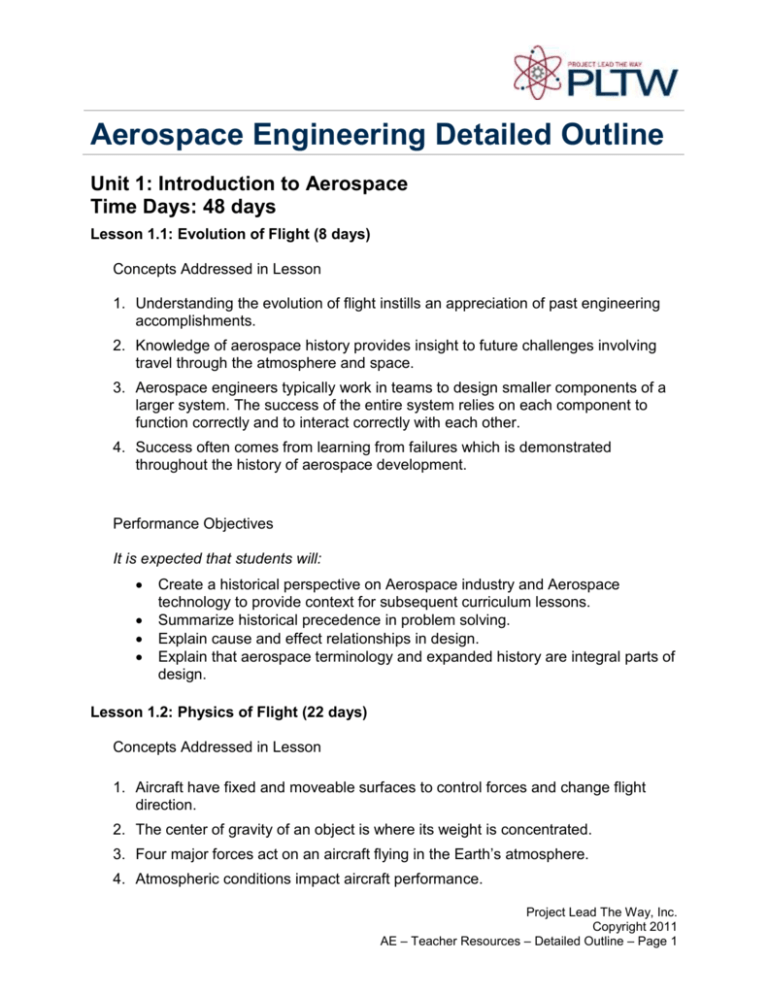
Aerospace Engineering Detailed Outline Unit 1: Introduction to Aerospace Time Days: 48 days Lesson 1.1: Evolution of Flight (8 days) Concepts Addressed in Lesson 1. Understanding the evolution of flight instills an appreciation of past engineering accomplishments. 2. Knowledge of aerospace history provides insight to future challenges involving travel through the atmosphere and space. 3. Aerospace engineers typically work in teams to design smaller components of a larger system. The success of the entire system relies on each component to function correctly and to interact correctly with each other. 4. Success often comes from learning from failures which is demonstrated throughout the history of aerospace development. Performance Objectives It is expected that students will: Create a historical perspective on Aerospace industry and Aerospace technology to provide context for subsequent curriculum lessons. Summarize historical precedence in problem solving. Explain cause and effect relationships in design. Explain that aerospace terminology and expanded history are integral parts of design. Lesson 1.2: Physics of Flight (22 days) Concepts Addressed in Lesson 1. Aircraft have fixed and moveable surfaces to control forces and change flight direction. 2. The center of gravity of an object is where its weight is concentrated. 3. Four major forces act on an aircraft flying in the Earth’s atmosphere. 4. Atmospheric conditions impact aircraft performance. Project Lead The Way, Inc. Copyright 2011 AE – Teacher Resources – Detailed Outline – Page 1 5. Lift and drag are generated by fluid flow around an airfoil. 6. Aircraft performance can be simulated in a safe and cost effective environment. 7. Wind tunnels allow the performance of shapes to be tested in real fluid flow. 8. Gliders are designed to fly long distances without a system to produce thrust. Performance Objectives It is expected that students will: Determine the center of gravity location of an aircraft. Explain how aircraft are designed for stability and control. Design and analyze an airfoil considering lift and drag. Use the lift and draft equations to calculate associated forces and conditions. Describe the requirements for a glider to remain stable in flight. Design and construct a glider that meets the design requirements provided by the instructor. Summarize test data to evaluate glider performance against design criteria. Lesson 1.3: Flight Planning and Navigation (18 days) Concepts Addressed in Lesson 1. Simulations are widely used in the aerospace industry to develop skills which can be effectively applied to the actual device. 2. Each flight should be planned in advance of the actual flight. 3. Pilots then apply the principles of navigation to safely travel to their destinations. 4. The Global Positioning System, GPS, is a complex system designed to provide accurate location information to many users. 5. The history of navigation is intertwined with technology development. 6. Air traffic is coordinated within a complex system to improve safety and efficiency. Performance Objectives It is expected that students will: Explain the progression of navigation technology and its influence on navigation. Demonstrate aircraft control through the use of a flight simulator. Plan a flight and accurately navigate this plan using a flight simulator. Explain why simulators are valuable tools for preparing pilots to fly aircraft. Use the Global Positioning System, GPS, unit to navigate. Project Lead The Way, Inc. Copyright 2011 AE – Teacher Resources – Detailed Outline – Page 2 Unit 2: Aerospace Design Time Days: 49 days Lesson 2.1: Materials and Structures (20 days) Concepts Addressed in Lesson 1. Aerospace material selection is based upon many factors including mechanical, thermal, electromagnetic, and chemical properties. 2. Structural design, including centroid location, moment of inertia, and a material’s modulus of elasticity, are important considerations for an aircraft. 3. Static equilibrium occurs when the sum of all forces acting on a body is equal to zero. 4. Composites combine different materials to create a material with properties superior to that of the individual materials. 5. Material testing provides a reproducible evaluation of material properties. Performance Objectives It is expected that students will: Research the properties of materials used in the aerospace industry. Calculate and use properties of material. Design and analyze a frame system 3D modeling software. Create composite material. Determine material properties through testing. Lesson 2.2: Propulsion (18 days) Concepts Addressed in Lesson 1. Energy transformed between forms of energy produces propulsion. 2. Newton’s Three Laws of Motion are central to the idea of propulsion. 3. Engines vary in terms of efficiency, speed, and altitude. 4. Air and fuel are used for combustion. 5. Engine configuration impacts flight performance. 6. Rocket engines produce thrust through rapid expansion of gases. Performance Objectives It is expected that students will: Design an engine for an aircraft. Determine the thrust of an engine. Project Lead The Way, Inc. Copyright 2011 AE – Teacher Resources – Detailed Outline – Page 3 Design an effective model rocket. Research and investigate rocket engines for use in a rocket. Test a model rocket to perform as predicted. Identify the main propulsion systems and the parts of a rocket engine. Compare the advantages and disadvantages of various rocket systems. Explain the rocket types used by various spacecraft. Explain how Newton’s three laws of motion relate to rocket propulsion. Lesson 2.3: Flight Physiology (11 days) Concepts Addressed in Lesson 1. The capabilities and limitations of the human body need to be understood by pilots, crews, and aerospace engineers. 2. An aerospace engineer considers the human interaction with the machine for more effective designs. 3. The human body consists of systems that work together to ensure functionality and life. 4. Extreme environments and forces can harm or kill a human. Performance Objectives It is expected that students will: Determine individual human factors. Identify applications of human factors in aerospace engineering. Apply human factors in an aerospace engineering design. Explore an aviation accident and report on its causes. Unit 3: Space Time Days: 30 days Lesson 3.1: Space Travel (11 Days) Concepts Addressed in Lesson 1. The universe exists in a scale that is difficult to conceptualize. 2. Space law is a system based on international agreements designed to promote the use of space for the good of all humankind. 3. The exploration of space is successful through learning from previous missions and the development of technology and systems. Performance Objectives Project Lead The Way, Inc. Copyright 2011 AE – Teacher Resources – Detailed Outline – Page 4 It is expected that students will: Describe the relative sizes of celestial bodies. Apply space law to an accident involving space hardware. Explain how technology development is intertwined into the culture of a nation. Design a space junk mitigation system. Lesson 3.2: Orbital Mechanics (19 Days) Concepts Addressed in Lesson 1. Orbital mechanics provides a means for describing orbital behavior of bodies. 2. The same laws that govern satellite orbits also govern celestial body (e.g. comets, planets and moons) orbits. 3. All objects exert an attraction force to each other. 4. Objects orbit other objects in a pattern governed by forces exerted on each other. 5. Objects in orbit are continuously falling toward the body about around which they orbit. 6. Orbital elements can be used to fully define a satellite’s orbit, allowing the accurate prediction of the precise location of the satellite at a given time. 7. A satellite’s mission is a major factor when designing its orbit. Performance Objectives It is expected that students will: Describe the contributions to orbital theory of the discipline’s historical figures. Define the six orbital parameters that describe an orbit. Design and simulate the path of an orbiting body. Calculate the energy of an orbiting body. Unit 4: Alternative Applications Time: 44 Days Lesson 4.1: Alternative Applications (11 Days) Concepts Addressed in Lesson 1. Aerospace concepts traditionally considered applicable to flight can be used in a variety of applications and industries. 2. Fluid movement is an important consideration in the design of many products. 3. Air travel impacts society and the environment in many ways. Project Lead The Way, Inc. Copyright 2011 AE – Teacher Resources – Detailed Outline – Page 5 4. Efficiency is major criteria for aircraft design. Performance Objectives It is expected that students will: Apply aerospace engineering concepts into design or industries not intended for flight. Describe the impact of air travel on society and the environment. Apply concepts of the product life cycle to the aerospace industry. Identify alternative methods of sustainability for flight in the future. Justify the need for efficiency in design relating to cost and economic impact. Lesson 4.2: Remote Systems (25 Days) Concepts Addressed in Lesson 1. Remote system designs are used in air, ground, maritime, and space environments. 2. Remote system design is based upon the integrated system design of mechanical, electrical, and software systems. 3. Remote systems use sensor feedback to modify behavior. 4. Operator input is established through the use of an operator interface and a means to communicate with the remote system. 5. Remote systems can be designed to perform an extended operation with little human input or impact. Performance Objectives It is expected that students will: Describe the impact of a communication delay on the success of a mission. Design and create a functional remote system, including integration of structural, mechanical, electrical, and software systems. Demonstrate proper setup and operation of remote system sensor inputs. Interpret remote system data and create a visual data representation. Operate a remote system through a series of performance tasks including autonomous navigation. Lesson 4.3: Aerospace Careers (8 Days) Concepts Addressed in Lesson 1. Career planning should consider many factors. Project Lead The Way, Inc. Copyright 2011 AE – Teacher Resources – Detailed Outline – Page 6 2. Career planning should begin by exploring one’s own interests and understanding possible options. 3. The wide variety of career paths available to students requires careful consideration for future professional success. Performance Objectives It is expected that students will: Develop a career plan to achieve their vision as a future professional. Conduct an interview with a professional. Prepare a presentation for peer review. Project Lead The Way, Inc. Copyright 2011 AE – Teacher Resources – Detailed Outline – Page 7
